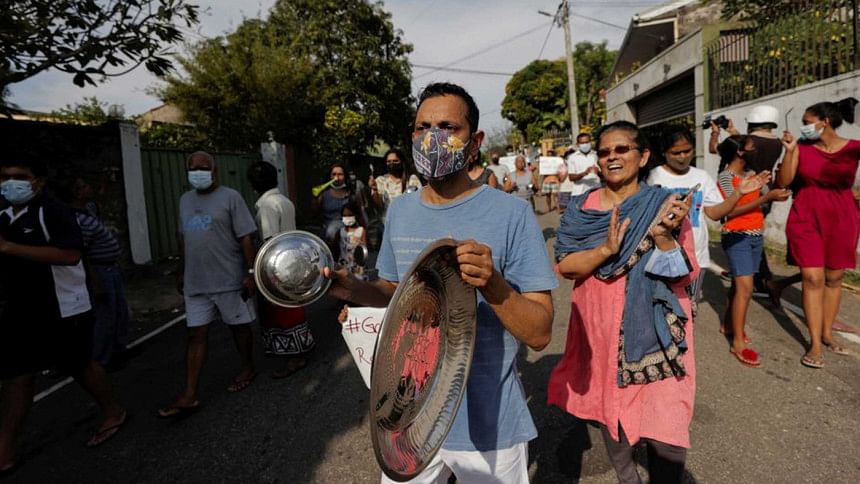Bangladesh, Pakistan and Sri Lanka: A Comparative Anatomy

South Asia has been one of the fastest growing regions in the modern world, driven mostly by India, Bangladesh, Sri Lanka, and Pakistan. However, Sri Lanka is now facing the worst political and economic crisis since its independence, and Imran Khan has been removed as the prime minister of Pakistan. The turmoil in these countries has led many to question whether Bangladesh, riding high on the wave of economic development, will suffer an impact of these crises. But the trajectory of these countries has differed in important ways, which implies that the challenges of Bangladesh are different. Let me explain how.
One thing that has been of concern is the debt-GDP ratio. Both Sri Lanka and Pakistan's national debt (percent of GDP) has been considerably higher than that of Bangladesh. In 2011, according to the World Development Indicators (WDI), Sri Lanka's national debt was around 70 percent of the country's GDP. In 2021, the figure shot up to above 100 percent as the economic crisis deepened. Pakistan's national debt (percent of GDP) has increased from around 60 percent to 87 percent during the same time period. On the other hand, Bangladesh has significantly lower national debt, hovering around 40 percent of its GDP in 2021. However, countries like the US and Japan have also had persistently high debt-GDP ratios.
There are other concurrent trends that make high debt-GDP ratio a cause for concern. One is the total foreign exchange reserves of a country. While the total reserves of Bangladesh have been increasing steadily over time, the trend for both Sri Lanka and Pakistan has been volatile. In February 2022, Sri Lanka's foreign exchange reserves fell to about USD 2.3 billion. Moreover, Bangladesh's total reserves—as percentage of external debt—stood at about 63.7 percent in 2020. The corresponding figures for Sri Lanka and Pakistan were approximately only 10 percent and 15.9 percent, respectively. Traditionally, foreign exchange reserves have been seen as a source of emergency funds to pay for imports in the event of an economic crisis. Bangladesh's reserves at the moment can pay for nine months' worth of imports, while for Pakistan and Sri Lanka, the figure is considerably lower, about four months and three months, respectively.
The debt-GDP ratio is problematic when the average interest rate to be paid for the loans of a country falls below its GDP growth rate. Deficit financing shifts the burden of paying off loans from current to future generations. If deficit financing leads to higher growth, purchasing power and standard of living, then this burden is minimised as the future generation's ability to pay increases. Thus, deficit financing coupled with stable growth as well as improvement in other development indicators should not be a cause for too much concern, which is the case for Bangladesh, but not for Sri Lanka or Pakistan.
Furthermore, Bangladesh's GDP had steadily attained faster growth rate (starting from around 6.5 percent in 2011 and increasing to nearly eight percent in 2019), while Sri Lanka's growth rate, starting from a high of around nine percent in 2011, steadily declined, and when the pandemic hit in 2020, its economy significantly shrank, whereas Bangladesh was still able to sustain positive growth rate (around 3.5 percent in 2020). Pakistan was also steadily growing, albeit at a lower rate than Bangladesh, until the pandemic struck and their economy shrank too.
The important takeaway is to observe the dynamic trends of the indicators across these three countries. The striking feature of Bangladesh's trajectory is sustained improvement, while volatility and decline mark the trends in Sri Lanka and Pakistan.
Next, for one of the proximate factors contributing to the crisis in Sri Lanka, a sudden ban on import of chemical fertilisers and other agrochemicals a year ago to focus on organic-only agriculture decimated the country's agricultural production and led to a soaring inflation driven by food prices. However, the shift to organic farming has been on the cards for some time in the country. What mattered was the sudden nature of the policy, and a failure to understand the farmers' ability to adapt with the changes the policy would entail. Verité Research, a Colombo-based analysis firm, found in a survey that only about 10 percent of Sri Lankan farmers cultivated without chemical fertilisers. These findings imply that such a ban on import of chemical fertilisers, no matter how well-intentioned (such as to alleviate health related concerns and to reduce spending on import to ease pressure on dwindling foreign reserves), were doomed to fail.
My final thoughts on this discussion are these: Bangladesh is in no danger of an imminent crisis like Sri Lanka or Pakistan. The trajectory, and indeed even the starting point of Bangladesh is drastically different. Compared to Bangladesh, Sri Lanka had a historically higher life expectancy, education attainment and also performed better in some other socioeconomic indicators. More importantly, the motivation for and the dynamic developments that lead to new policies are vital, more so in this age of intertwined economies and global trade patterns. Even if policies are targeted towards increasing welfare, one has to keep in mind the dynamics of the economy, the ability of its citizens to adapt, and the international geopolitical climate. So far, Bangladesh has been managing all these well, as shown by the steady performance in major macroeconomic indicators.
An economic and political crisis, I suspect, will be preceded by sustained poor performance in significant areas, and there will be warning signs, such as declining export earnings, unforeseen increase in import spending, fiscal deficit, reduced remittance, etc. It is up to our policymakers, economists and experts from other fields to be able to notice and act on these omens if and when they occur.
Mahir A Rahman is a research associate at Bangladesh Institute of Development Studies (BIDS)

 For all latest news, follow The Daily Star's Google News channel.
For all latest news, follow The Daily Star's Google News channel. 







Comments